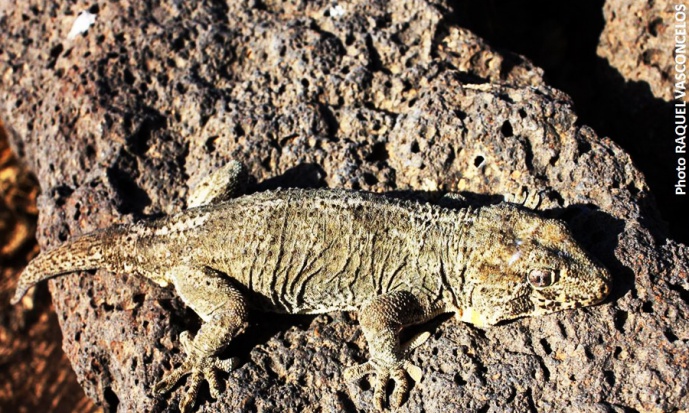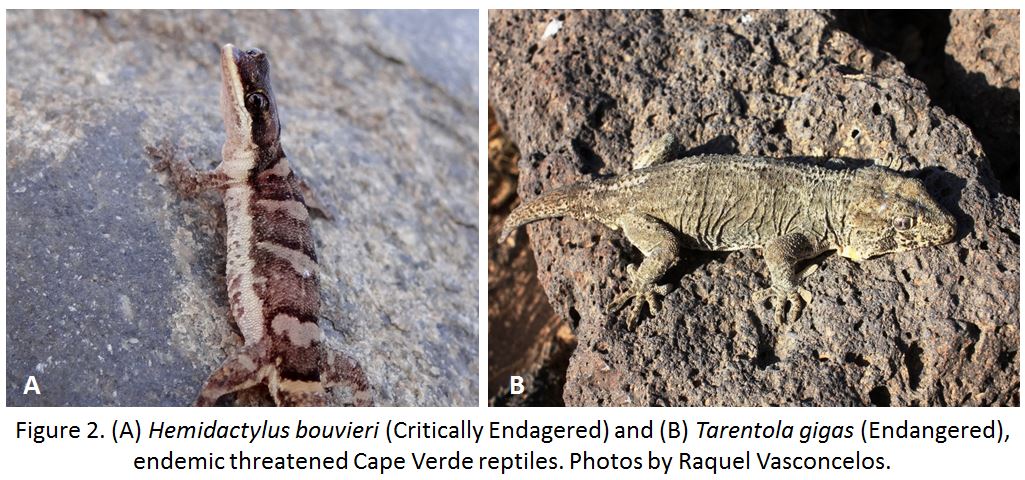CIBIO/InBIO RESEARCHERS' WORK ON THE DISTRIBUTION AND CONSERVATION STATUS OF THE TERRESTRIAL CAPE VERDEAN HERPETOFAUNA HIGHLIGHTED BY THE IUCN

Thanks to the work of a team of researchers from CIBIO/InBIO, the conservation status of the terrestrial reptiles of the Cape Verde Island are now available at the IUCN Red List website. In a study published in Oryx last January (Vasconcelos et al., 2013), Raquel Vasconcelos (CIBIO/InBIO and Institut de Biologia Evolutiva – IBE, Consejo Superior de Investigaciones Científicas–Universitat Pompeu Fabra - CSIC-UPF), José Carlos Brito (CIBIO/InBIO), Salvador Carranza (IBE, CSIC-UPF) and James Harris (CIBIO/InBIO) review the distribution and conservation status of the terrestrial Cape Verdean herpetofauna.
Their findings have been recently highlighted in IUCN’s international news release about the latest update of the IUCN Red List of Threatened Species™.
Preserving biodiversity in island populations
The preservation of biodiversity is a key issue on the agendas of policy makers, scientists, environmentalists and increasingly, the general population. In spite of the ongoing efforts to prevent diversity loss, a vast array of species is still at risk of extinction. Island populations are of particular concern, given their limited range of distribution and high vulnerability to the introduction of exotic species. Therefore, it is necessary to deepen the knowledge about the species that natively inhabit these environments with the purpose of improving the effectiveness of the conservation planning strategies put forth.
Cape Verde’s terrestrial herpetofauna
Cape Verde is a tropical dry archipelago located in the Atlantic Ocean, in the biogeographical region of Macronesia, comprising 10 islands and several islets of volcanic origin. Cape Verde has a higher number of reptile taxa and endemics than any of the five archipelagos in Macaronesia. Nevertheless, detailed information about the distribution of terrestrial reptile biodiversity in this region was missing. Hence, outlining the precise distribution of these reptiles and assessing their conservation status were the first steps towards a sounder understanding of their diversity, as required for their effective conservation.
Paving the way for the conservation of Cape Verde’s terrestrial reptiles
By carrying out extensive fieldwork and an exhaustive analysis of post-1980 literature, the researchers were able to present the first accurate depiction of the distribution of Cape Verde’s terrestrial reptiles based on within-island information. Most importantly, they produced a revised assessment of the conservation status for all taxa following IUCN criteria and using RAMAS software, including many which were previously classified as Data Deficient or Undetermined.
Amongst their findings, the team verified that one taxon - Chioninia coctei (Figure 1) - continues to be considered Extinct. They also observed that geckos are rarer than skinks, arguably due to their high habitat specialization, with more than half occurring on only one island/islet.
Worryingly, about half of all taxa, especially the endemic Hemidactylus and Tarentola gigas (Figure 2), were found to be Critically Endangered and Endangered, respectively. This number represents twice the proportion of those in the Canary Islands, a difference that could be explained by the smaller area and greater aridity of the Cape Verde islands.

The criterion most frequently used for threat categorizations was geographical range, and the three main types of threats posed to these animals were reportedly: i) natural disasters, such as drought and volcanic activity; ii) intrinsic factors of the species, as for instance low density and restricted distribution range; and iii) the introduction of exotic species.
While further studies are necessary to fully grasp the biology and demography of the threatened reptiles of Cape Verde, the work carried out by Raquel and collaborators’ advances the knowledge in this scope and informs the definition of conservation priorities. The researchers intend to share these insights with Cape Verde’s governmental authorities, aiming to scaffold the effective protection of the islands’ biodiversity. Although it is important to keep in mind that, ultimately, the achievement of this goal also depends on the availability of the funding required to set and sustain a protected area network and proper conservation actions.
For further details on this study, please see the original article: Vasconcelos R, Brito JC, Carranza S, Harris DJ (2013). Review of the distribution and conservation status of the terrestrial reptiles of the Cape Verde Islands. Oryx, 47: 77-87
You can also check the press release about the latest update of the IUCN Red List of Threatened Species™ here.